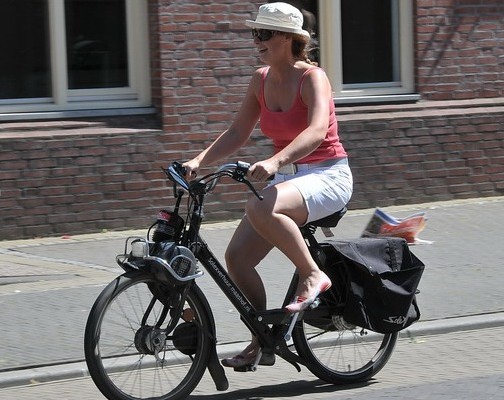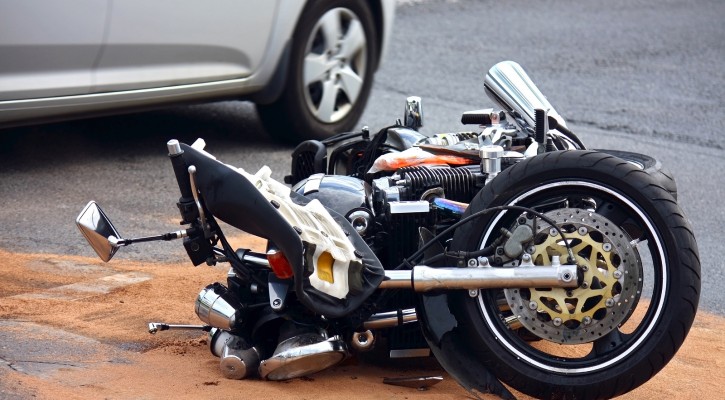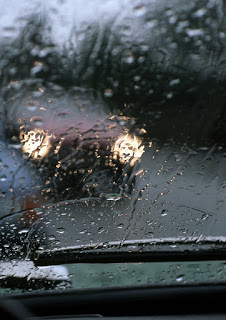Tag Archive: safety

Scooter Safety for Riders and Other Motorists
September 23, 2009
They are popping up everywhere; on college campuses, in urban areas, neighborhoods, and in retirement communities. Whether it’s for fun, cost savings, environmental considerations or out of practicality, scooters and mopeds are growing in use and popularity. While these scooters are zipping about, everyone on the roadways needs to take extra precautions with mopeds and scooters in the driving environment.
Motorist should keep in mind that it is difficult to judge how fast a scooter or moped is traveling.
They are also smaller, difficult to see, and appear farther away than they really are. Maintain your scan of the road to ensure you are aware of their location and continually check your blind spots. Always manage your space cushion and continue to adjust with the flow of traffic as you never know when a scooter will need to make an evasive maneuver. Increase your following distance to a minimum of four seconds in ideal weather conditions and 5 seconds in inclement weather and at night. Even wind can affect the stability and direction a scooter travels. Dim your high beams at night when approaching a moped or scooter as they are more susceptible to their blinding affect.
If traveling by a moped or scooter take extra precautions. Check to make sure you have met all the legal licensing, registration and equipment requirements for your local and state area before travelling on the road. Some vehicles with a motor capacity of 50cc are classified as a motorcycle and require a Motorcycle Safety Course. Know before you go. It is helpful to take a motorcycle practice test prior to taking your safety course.
Make sure your equipment is working and in excellent condition. Poor tire tread, improper inflation, worn brakes and equipment malfunctions can be huge problems on the road. Evaluate your load, cargo and whether to have a passenger as they directly affect your vehicles stability, performance and ability to maneuver.
Wear clothing that will give the greatest protection in a fall. Choose clothing that is light, bright and snug. If traveling during dawn, dusk or nighttime hours, add reflective tape to clothing for increased visibility. Consider boots, a jacket, long pants and gloves. Protect your eyes with safety glasses or goggles.
Head injury is a leading cause of death and disability in moped and motor scooter crashes. Wearing a helmet is the single most effective means to prevent head injury. Ensure that your helmet fits properly and is Department of Transportation (DOT) approved. Helmet use is mandatory in most states.
On the roadway, give yourself plenty of space from all sides. Travel in the center of the lane and if riding with other motor scooters travel in a staggered formation. Always drive defensively; looking for an escape route, should you need to make an evasive maneuver. Keep a three to five second visual scan and be sure to check your blind spots. Turning your headlights on during the day can improve your ability to be seen by pedestrians and other vehicles. When riding, your hands should be on the handlebars and your feet on the floorboards. Watch out for road hazards and defects. Signal well in advance, and consider using hand signals for extra safety.
Be extra cautious when approaching driveways, parking lots, and intersections. Reduce your speed for lower visibility conditions such as dawn, dusk, nighttime and poor weather. Avoid having sudden starts, braking and quick turns as they cause instability.
When reaching your destination, park on level ground, turn off the engine and if you have any passengers let them get off the scooter first.
With awareness and a few extra precautions, mopeds and scooters can operate safely on our roads.

Sharing the Road with Motorcycles
February 19, 2009
Motorcycles are less stable and less visible than cars, and they have high performance capabilities. For these and other reasons, motorcycles are more likely than cars to be in crashes. And when motorcycles crash, their riders lack the protection of an enclosed vehicle, so they’re more likely to be injured or killed. Per mile traveled, the number of deaths on motorcycles is about 26 times the number in cars. A rider who isn’t wearing a helmet is 40 percent more likely to suffer a fatal head injury, compared with a helmeted rider.
The actions of motorcyclists can affect motor vehicle operators in numerous ways. When you follow a motorcycle, remember that motorcycles have the ability of stopping much more quickly than other vehicles in emergencies. Following too closely endangers your life and that of the motorcyclist.
In addition to maintaining a safe following distance from motorcyclists in front of you, check your rearview mirror and be aware of motorcyclists following you. When a motorcyclist is following you, be especially careful not to make any sudden stops.
Weather and road conditions present greater problems to the motorcyclist than to the driver of a motor vehicle. A puddle may hide a hole that jolts your car; the same hidden hole can throw a motorcycle out of control. When it rains, reduced traction makes it difficult for a motorcyclist to balance. It is more difficult for the motorcyclist to stay in control on slippery roads. Wet or icy roads impair a motorcyclist’s ability to brake and maneuver. Wind gusts can move a motorcycle across an entire lane. Gravel roads decrease traction and may cause a rider to slow down or brake where a car would not. Allow extra space for motorcycles in all adverse conditions. Use extra care when you are following a motorcyclist that is crossing railroad tracks. Railroad tracks present a special problem for motorcyclists, because motorcycle tires can get caught in the grooves of the crossing, causing the rider to lose her or his balance.
When you are following a motorcycle that is carrying a passenger, use extra caution. Passengers change the way the motorcyclist should operate. A motorcyclist who is inexperienced in transporting a passenger may have extra difficulties with balancing and controlling the motorcycle.
Learn more about motorcycle safety and sharing the road with motorcycles.
Roadside Safety: What to Do If You Have a Breakdown
February 11, 2009
Vehicle breakdowns are stressful and can even be frightening, depending on the circumstances. If your vehicle won’t start in a parking lot, you have the advantage of being stopped in a safe place, but if the breakdown occurs while you are driving, you must take immediate action to ensure the safety of you and your passengers.
First, don’t panic. Panicking may cause you to make the situation even more dangerous. Stay calm and follow a logical progression to get your vehicle safely off the highway.
Your first action should be to slow down. You should also look for a safe place to pull over, but you must have slowed your vehicle sufficiently to use the space you locate. Remember that if you pull off the pavement, your vehicle will lose traction; if you haven’t slowed down enough, your vehicle could skid.
Once you have located a safe place to pull off the road, try to park where the disabled vehicle can be seen for at least 200 feet in each direction. Avoid pulling off in a curve or near a hill. Move the vehicle so all four wheels are off the pavement or traveled portion of the roadway.
In addition to making your vehicle visible, you must make it obvious that the vehicle is stopped. This is particularly important:
- at night or in bad weather such as rain or fog, when drivers may be using the lights of other vehicles to guide them
- considering drivers who may be sleepy or even under the influence of alcohol or drugs
- on the highway, where drivers may be suffering from “highway hypnosis,” a condition that sometimes occurs for people on a long trip
Turn on your emergency flashers, tie a white cloth to the left door handle or antenna, and raise the hood to indicate that your vehicle is stopped and disabled.

Environmental Effects on Driving a Car
January 29, 2009
We cannot avoid environmental conditions when we drive. Sometimes, conditions are favorable: a clear day with good visibility. Other times, challenging environmental conditions such as rain, fog and wind exist. Understanding how to properly handle these challenging conditions will make driving in them safer and less stressful.
Even a day filled with sunshine can present problems when driving. Too much light can make it difficult to see ahead. Wear sunglasses or use your sun visor. Always keep the lower edge of the sun visor pushed toward the windshield. Clean the inside of your windshield and all windows at least once per week. Sunshine on a dirty windshield creates glare.
Night driving requires adjustments too. The lack of light reduces detail and conceals hazards such as pedestrians, bicycles, stalled cars, and curves. It is more difficult to judge the speed and position of other vehicles. You must depend largely on your headlights, which will show only a relatively short and narrow path ahead. Headlights do not bend around corners; they will only illuminate what is directly in front of you. Highway lighting may be limited. Glare from roadway lights, business signs, and the headlights of oncoming vehicles may impair your visibility.
Other conditions that can greatly affect visibility are fog, haze, smoke and mist. Be especially careful of patches of fog in valleys and low-lying areas. It is best not to drive in fog or smoke. If you must, slow down, turn on your low beam headlights, and be ready for a fast stop. Be alert for slow-moving or stopped traffic. Check your rearview mirrors frequently for vehicles that are approaching quickly from the rear. Use windshield wipers in heavy fog. If the fog or smoke becomes so thick that you cannot see well enough to keep driving, pull off the road until conditions improve. Pull over as far to the right as possible, off the main travel portion of the roadway. Leave your parking lights on and activate your hazard lights.
During rainy conditions, wet roads will increase stopping distance. Roads are most slippery just after it begins to rain because the rain mixes with oil dropped from cars onto the road, creating a very slick surface.
When you are driving in the rain, slow down. Driving too fast in the rain makes hydroplaning more likely. When a car hydroplanes, the tires ride on a thin film of water instead of on the road. When this happens, you can easily lose control and skid. Your vehicle can hydroplane in as little as 1/16 of an inch of water. If the tread on your tires is worn, your vehicle is more likely to hydroplane. Besides slowing down, you can also reduce your chances of hydroplaning by making sure your tires have the right air pressure and good tread. If your vehicle hydroplanes, ease your foot off the gas and allow your vehicle to slow down until your tires gain traction with the road.

School Bus Safety Tips for Drivers and Children
January 28, 2009
For 23 million students nationwide, the school day begins and ends with a trip on a school bus. The greatest risk is not riding the bus, but approaching or leaving the bus.
According to the National Highway Traffic Safety Administration (NHTSA), since 1997, 152 school-age pedestrians (younger than 19) have died in school transportation-related crashes. One-half (50%) of all school-age pedestrians killed in school transportation-related crashes were between the ages of 5 and 7. More school-age pedestrians have been killed between the hours of 3 and 4 p.m. than any other time of day.
The NHTSA offers school bus safety tips for both drivers and children. You can use these safety tips to raise the awareness of the potential hazards with your children, as well as become a safe driver yourself.
Tips for Drivers
- Learn and obey the school bus laws in your state.
- Learn the “flashing signal light system” that school bus drivers use to alert motorists of pending actions:
–Yellow flashing lights indicate that the bus is preparing to stop to load or unload children. Motorists should slow down and prepare to stop their vehicles.
–Red flashing lights and extended stop arms indicate that the bus has stopped, and that children are getting on or off. Motorists must stop their cars and wait until the red lights stop flashing, the extended stop sign is withdrawn, and the bus begins moving before they can start driving again. - When driving in neighborhoods with school zones, watch out for young people who may be thinking about getting to school, but may not be thinking of getting there safely. Slow down.
- Watch for children playing and congregating near bus stops. Be alert. Children arriving late for the bus may dart into the street with out looking for traffic.
- When backing out of a driveway or leaving a garage, watch out for children walking or bicycling to school.
Tips for Children
- Arrive at the bus stop at least five minutes before the bus is scheduled to arrive.
- When the bus approaches, stand at least three giant steps (6 feet) away from the curb, and line up away from the street.
- Wait until the bus stops, the door opens, and the driver says that it’s okay before stepping onto the bus. Use the handrails to avoid falls.
- When exiting the bus, be careful that clothing with drawstrings and book bags with straps don’t get caught in the handrails or doors. Walk at least three giant steps away from the side of the bus.
- If you drop something near the bus, tell the bus driver. Never try to pick it up because the driver may not be able to see you.
- If you have to cross the street in front of the bus, walk on the sidewalk or along the side of the road to a point at least five giant steps (10 feet) ahead of the bus before you cross. Be sure that the bus driver can see you, and you can see the bus driver.
- Never walk behind the bus.
